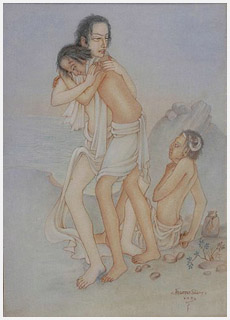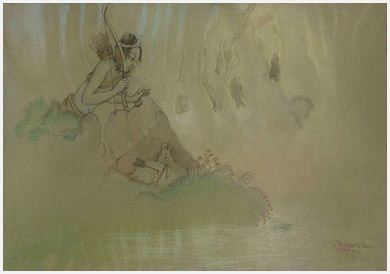SARADA
CHARAN UKIL
|
| |
|
| |

14/11/1888 - 21/07/1940

|
| |
|
| |
|
|
|
 |
Artist Profile |
BEGINNINGS
Born in Telirbagh, Bangladesh. 1918 Arrived in New
Delhi. 1926 Founder member, Sarada Ukil School of Art,
New Delhi. Sarada Ukil felt the need to put forward
Delhis art and culture both in National and International
level and as result in 1928, AIFACS was established
in New Delhi.
EDUCATION
- 1905-07 Diploma in Mechanical Draughtsmanship,
Govt. School of Art, Calcutta.
- 1907-11 Diploma in Painting, Govt. School of Art,
Calcutta.
|
| |
EXHIBITIONS
- 1914 Exhb. organised by Indian Society of Oriental
Art, Paris.
- 1914-22 Annual Exhb., Indian Society of Oriental
Art, Calcutta.
- 1923 Exhb., Bombay Art Society, Bombay.
- 1924 Annual Exhb., New Delhi.
- 1925 Exhb., Theosophical Society, Madras.
- 1926-29, Exhb., Geneva, Hague, London and Dublin.
- 1927 Exhb., Simla Fine Art Society, Simla.
- 1929 Solo exhb., Imperial Gallery of Art, London.
- 1930 Mysore Dusshera Exhb., Mysore.
- 1931 Mysore Art Exhb, Mysore.
- 1932 Solo exhb., India House, London.
- 1940 Annual Exhb., AIFACS, New Delhi.
- 2004 Manifestations II, organised by Delhi Art Gallery,
Jehangir Art Gallery, Mumbai and Delhi Art Gallery,
New Delhi.
COLLECTION
- Jagamohan Palace, Mysore.
- Sri Chitra Art Gallery, Thiruvananthapuram.
- National Gallery of Modern Art, New Delhi.
- Academy of Fine Arts, Kolkata.
- Salarjung Museum, Hyderabad.
- Royal families of Travancore, Mysore, Patiala, Jaipur,
Mandi, Chamba, Coochbehar and Bilaspur.
- Lord Willingdon.
- Willium Rothenstien.
- Mr. Ramsey Macdonald.
- Lord Zetland.
- Mr. G.D. Birla.
- Delhi Art Gallery, New Delhi.
AWARDS
- 1930, 31 Awarded the Viceroy Gold Cup, New Delhi.
- 1940 Gold medal, AIFACS, New Delhi.
STYLE
The early years of the 20th century saw the calm and
conducive weather of History Painting alternate with
Romanticism. The artists became visionaries who mirrored
a hazy past swayed by the powers of their imagination.
It was alluring, poetically ideal, but ethereal. They
painted in soft, tonal, analogous watercolour washes
wherein theme, mood and style reconciled in a dream.
Sarada as a painter explored the epics, history and
Indian mythology for the sake of his own artistic expedition
into the past. Sarada initiated the Delhi chapter of
the Bengal School. During the early 20th century, the
Bengal School provided an Indian alternative to the
colonial art education that ignored the local tradition.
It grew as a historical necessity and a response to
the nationalist movement to combat the colonial policy
of deculturation. The Indian intelligentsia welcomed
the School as mainstream Indian art. Pluralistic in
nature, it developed local variations. Sarada too developed
his stylistic trai
TEACHING EXPERIENCE
1912-17 Art Teacher at Gouripur, Assam. 1918 Art Teacher,
Modern School, New Delhi. 1926 Taught at Sarada Ukil
School of Art, New Delhi.

back |
| |
|
|



